
6.02.24
The efficiency of a warehouse is intricately tied to its safety protocols. A lapse can cost not just in terms of finances, but more critically, human lives. Here’s a crucial and comprehensive warehouse safety checklist that every logistics company should consider. This isn’t just about ticking boxes; it’s about fostering a culture of care and precaution.

Ensure your warehouse is fire-ready. Install fire alarms for early warnings and make sure exits are clear and easily accessible. Fire safety is a critical aspect of warehouse security, and early detection can save lives and property.
In addition to fire alarms, consider investing in fire suppression systems, like sprinklers, to further enhance fire safety. Regular fire drills can also ensure that your team knows exactly how to respond in case of a fire emergency.
Regularly inspect and maintain electrical wiring to ensure smooth, tension-free operation. Faulty electrical systems can pose serious risks, so prevention is key.
Conduct an electrical load analysis to ensure that your warehouse’s electrical capacity matches its operational requirements. Overloaded circuits can lead to electrical hazards.
Promptly address hazards like cracks or spills on the warehouse floor. These seemingly minor issues can lead to slips and falls, causing injuries and disruptions.
Implement anti-slip floor coatings and designate specific areas for material storage to minimize floor hazards. Regular floor maintenance can prevent accidents.
Maintain your warehouse equipment properly, ensure your staff is well-trained in its operation, and report any malfunctions promptly. Proper equipment maintenance is crucial for both safety and efficiency.
Implement a preventive maintenance schedule for your equipment to reduce downtime and prevent accidents caused by equipment failure.
Handle hazardous materials with care. Clearly label and store them safely, and provide comprehensive training on their proper handling. Mishandling hazardous materials can have severe consequences.
Create designated storage areas with proper ventilation and containment measures for hazardous materials. Keep safety data sheets readily accessible for all employees.
Develop and regularly review emergency plans for your warehouse. Train your team for evacuations and ensure the availability of necessary emergency equipment. Preparedness is the key to minimizing risks during critical situations.
Insight: Conduct regular emergency drills and simulations to ensure that everyone knows their roles and responsibilities during emergencies. Update emergency contact lists and evacuation routes regularly.
Train your team in proper loading procedures, ensure they use appropriate gear, and take measures to prevent loading injuries. Loading areas can be accident-prone, so vigilance is essential.
Implement loading bay safety measures, such as safety barriers and clear signage, to reduce the risk of accidents during loading and unloading operations.
Ensure well-lit areas in your warehouse. Replace burnt-out bulbs promptly and add extra lighting where needed. Adequate lighting is crucial for both safety and efficient operations.
Consider energy-efficient LED lighting solutions to improve lighting quality while reducing energy consumption and maintenance costs.
Conduct regular inspections for hazards, promptly address them, and encourage your team to report safety concerns. Proactive inspections and a culture of safety reporting can prevent accidents.
Implement a safety committee within your warehouse to involve employees in safety initiatives and inspections. Encourage anonymous reporting channels for safety concerns to promote open communication.
In the world of logistics, safety is not just a regulatory requirement; it’s a moral obligation. Implementing these safety guidelines isn’t just about compliance; it’s about protecting the well-being of your employees and the success of your operations. By fostering a culture of care and precaution, you can ensure that your warehouse remains a safe and efficient workspace.